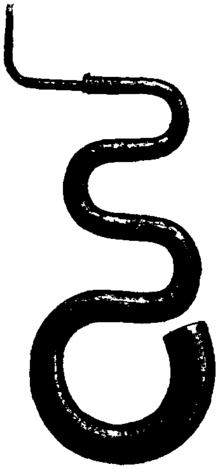Pavane
The pavane, pavan, paven, pavin, pavian, pavine, or pavyn (It. pavana, padovana; Ger. Paduana) is a slow processional dance common in Europe during the 16th century (Renaissance).
The pavane, the earliest-known example of which was published in Venice by Ottaviano Petrucci, in Joan Ambrosio Dalza's Intabolatura de lauto libro quarto in 1508, is a sedate and dignified couple dance, similar to the 15th-century basse danse. The music which accompanied it appears originally to have been fast or moderately fast but, like many other dances, became slower over time (Brown 2001).
Origin of term
The origin of this term is not known. Possibilities include the word being
- from Italian "[danza] Padovana", meaning "[dance] typical of Padua" (as in Bergamask); this is consistent with the equivalent form, "Paduana",[1]
- or from the Spanish pavón meaning peacock (Sachs 1937, 356),
though the dance was "almost certainly of Italian origin" (Brown 2001).
History
The decorous sweep of the pavane suited the new more sober Spanish-influenced courtly manners of 16th century Italy. It appears in dance manuals in England, France, and Italy.
The pavane as a musical form survived long after the dance itself was abandoned, and well into the Baroque period, when it finally gave way to the allemande/courante sequence (Apel 1988, 259ff)>.
Music
- Slow duple metre (Double Time 2/2).
- Generally follows the form of A,A1, B,B1, C,C1.
- It generally uses counterpoint or homophonic accompaniment.
- Often accompanied by a tabor according to Arbeau (1967, 59–64) in a rhythmic pattern of minim-crotchet-crotchet (1/2-1/4-1/4) or similar.
- This dance was generally paired with the Galliard.
Dance
In Thoinot Arbeau's French dance manual, it is generally a dance for many couples in procession, with the dancers sometimes throwing in ornamentation (divisions) of the steps (Arbeau 1967, 59–66).
Modern use
The step used in the pavane survives to the modern day in the hesitation step sometimes used in weddings.
More recent works titled "pavane" often have a deliberately archaic mood. Examples include:
- The classical composition Pavane (1887) by Gabriel Fauré, a modern version of the Renaissance genre.
 |
|
| Problems playing this file? See media help. | |
- The classical composition Pavane pour une infante défunte (1899) by Maurice Ravel.
- The "Pavane of the Sons of the Morning" that closes scene 7 of Job: A Masque for Dancing, a ballet composed by Ralph Vaughan Williams in 1930 and first staged in 1931.
- "Pavane, the Girl with the Flaxen Hair", a dramatic script written and directed by Wyllis Cooper, inspired in part by Ravel's composition, for the old-time radio series Quiet Please (1947).
- The classical composition "Pavane: She's So Fine" (1994) from John's Book of Alleged Dances by John Coolidge Adams.
- The choreography The Moor’s Pavane (1949) by José Limón.
- The title of a song from Verehrt und Angespien, the second studio album of the folk metal band In Extremo.
- An instrumental entitled "Pavanne for the Sleeping Beauty" [sic] by Joe Walsh on his album So What.
- The fourth movement of the suite "The Fall of the House of Usher" from the progressive rock album Tales of Mystery and Imagination by The Alan Parsons Project (1976).
- The song Pavan from the progressive folk album Evensong by Amazing Blondel.
- The title of a song from Water Forest an album by Rurutia.
- The science fiction novel Pavane (1968) by British author Keith Roberts, about an alternative history in which the queen Elizabeth the First is assassinated, and the Armada wins in the year 1588.
- The song Pavane by Jon Lord, of the band Deep Purple, written and recorded for his solo album Sarabande.
- Eric Clapton released an acoustic demo song on his Facebook Page on September 30, 2014: "Pavane for Jay A" (http://clyp.it/kzbdzfqd) as an homage to skateboard pioneer Jay Adams who passed away Friday August 15, 2014 at age 53.
Notes
- ↑ the dialectal/old form "pavan" for the modern Italian adjective "padovano" is reflected also, for example, in the family name "Pavan", rather diffuse in northern Italy (Anon. 2000).
References
- Anon. 2000. Cognome: PAVAN, Presente in 976 comuni. gens.labo.net (accessed 30 November 2010)
- Apel, Willi. 1988. The History of Keyboard Music to 1700. Bloomington: Indiana University Press. ISBN 0-253-32795-4.
- Arbeau, Thoinot. 1967. Orchesography, translated by Mary Stewart Evans, with a new introduction and notes by Julia Sutton and a new Labanotation section by Mireille Backer and Julia Sutton. New York: Dover Publications. ISBN 0-486-21745-0.
- Brown, Alan. 2001. "Pavan". The New Grove Dictionary of Music and Musicians, second edition, edited by Stanley Sadie and John Tyrrell. London: Macmillan Publishers.
- Sachs, Curt. 1937. World History of the Dance, translated by Bessie Schönberg. New York: W. W. Norton & Co., Inc.
| ||||||||||||||||||||||||
